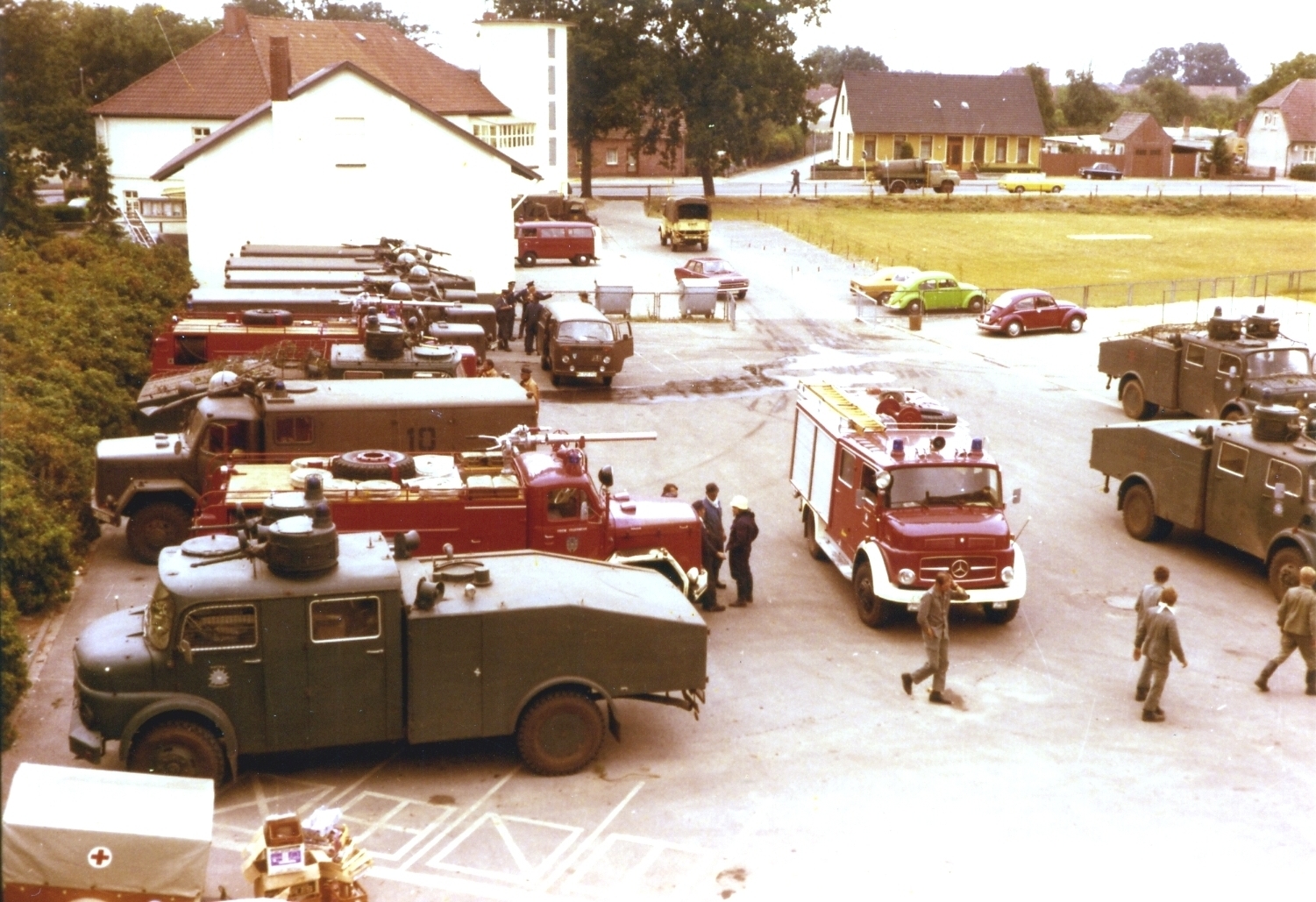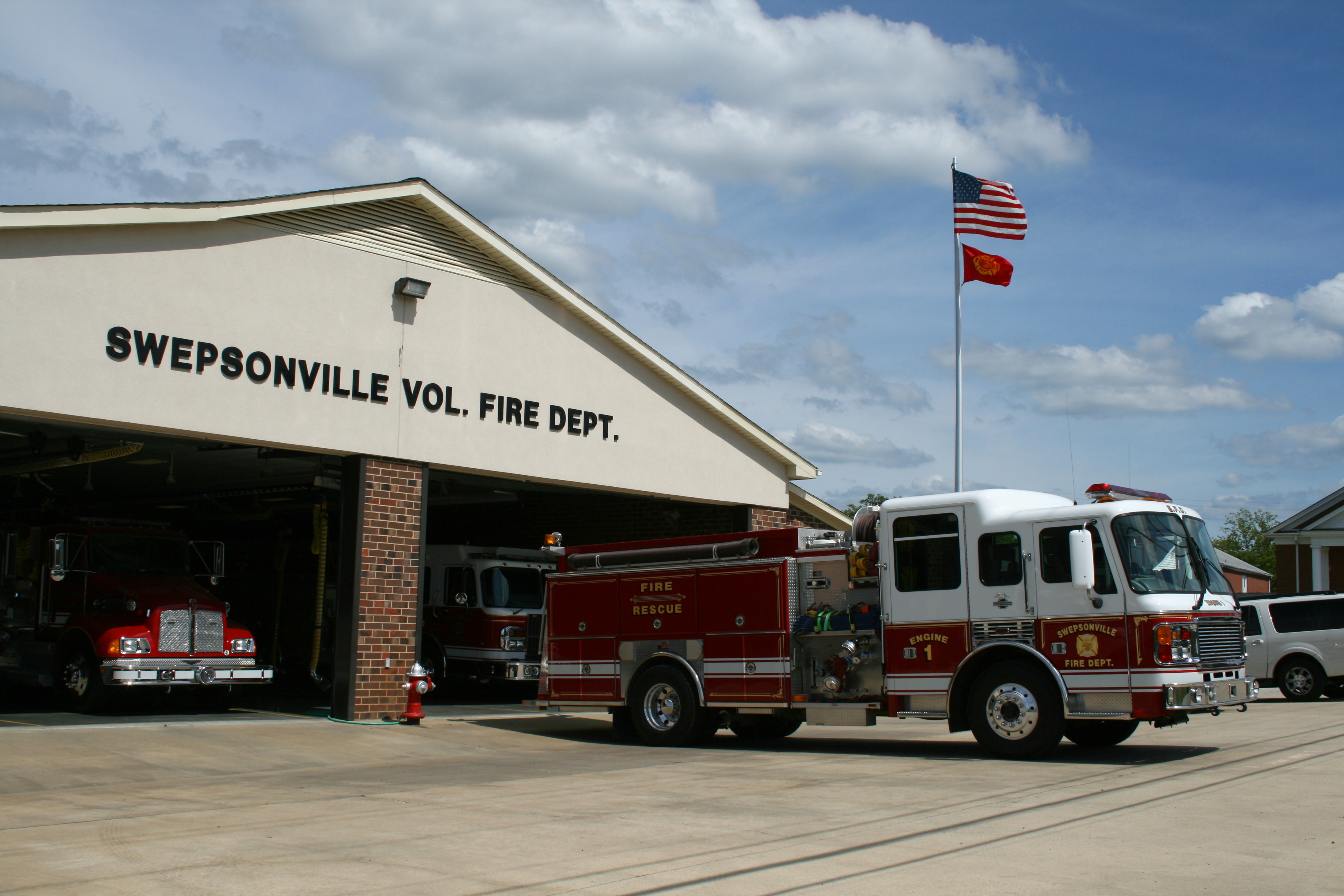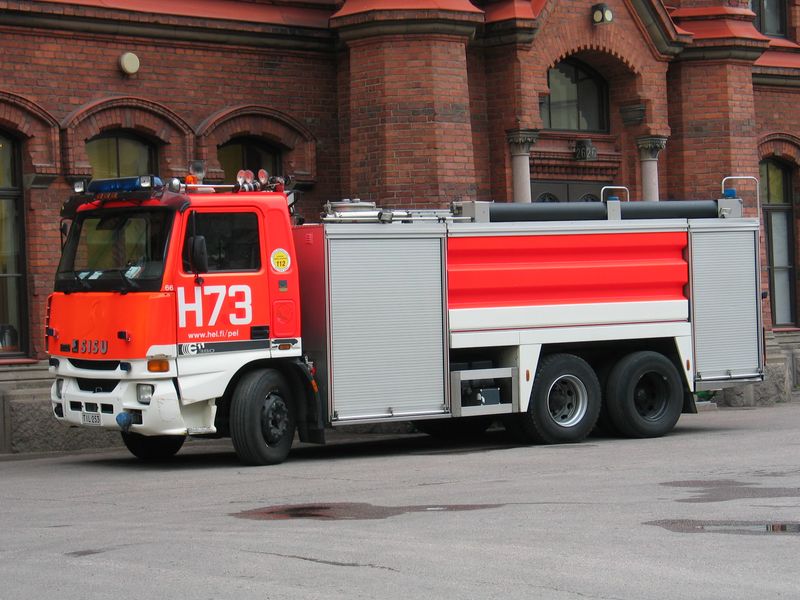|
Fire On The Lüneburg Heath
The fire on the Lüneburg Heath was a major forest fire in 1975 on the southern part of the Lüneburg Heath in north Germany, with various points of origin near Gifhorn, Eschede and Meinersen. To this day, it is the largest known forest fire in the Federal Republic of Germany. Causes The fire was aided by a long period of drought with hot summer weather and dried-out coniferous forests. Additionally, there was a lot of storm-damaged wood left in the wake of Hurricane Quimburga on 13 November 1972 that had not been cleared. The sources of the fire could only be reached with difficulty by the fire services over the unmetalled forest and heath tracks. Assisted by the monoculture of the area with its uniform stands of pines, the fire was able to spread rapidly and developed into a giant forest fire in parts of the districts of Gifhorn and Celle. The actual cause of the fire was only clarified in a few cases. At one place it was reckoned that the fire was started by sparks from th ... [...More Info...] [...Related Items...] OR: [Wikipedia] [Google] [Baidu] |
Lüneburg Heath
Lüneburg Heath (german: Lüneburger Heide) is a large area of heath, geest, and woodland in the northeastern part of the state of Lower Saxony in northern Germany. It forms part of the hinterland for the cities of Hamburg, Hanover and Bremen and is named after the town of Lüneburg. Most of the area is a nature reserve. Northern Low Saxon is still widely spoken in the region. Lüneburg Heath has extensive areas, and the most yellow of heathland, typical of those that covered most of the North German countryside until about 1800, but which have almost completely disappeared in other areas. The heaths were formed after the Neolithic period by overgrazing of the once widespread forests on the poor sandy soils of the geest, as this slightly hilly and sandy terrain in northern Europe is called. Lüneburg Heath is therefore a historic cultural landscape. The remaining areas of heath are kept clear mainly through grazing, especially by a North German breed of moorland sheep called the ... [...More Info...] [...Related Items...] OR: [Wikipedia] [Google] [Baidu] |
Neudorf-Platendorf
Neudorf-Platendorf is a village in the municipality of Sassenburg in Gifhorn district in the German state of Lower Saxony. As of 2020, its population is about 2,800. Gemeinde Sassenburg, accessed 10 April 2020 Geography Location The village lies east of the and the state forest of Dragen. The Aller flows by to the south. To the north and east lies the Großes Moor. The six kilometre long village street is ...[...More Info...] [...Related Items...] OR: [Wikipedia] [Google] [Baidu] |
Lüchow-Dannenberg
Lüchow-Dannenberg is a district in Lower Saxony, Germany, which is usually referred to as Hanoverian Wendland (''Hannoversches Wendland'') or Wendland. It is bounded by (from the west and clockwise) the districts of Uelzen and Lüneburg and the states of Mecklenburg-Western Pomerania (district of Ludwigslust-Parchim), Brandenburg (district of Prignitz) and Saxony-Anhalt (districts of Stendal and Altmarkkreis Salzwedel). History In medieval times the counties of Lüchow and Dannenberg occupied the area (from the early 12th century on). These counties were originally Slavic states that lost their independence to the Duchy of Brunswick-Lüneburg in the beginning of the 14th century. Since that time it was always an eastern extension of different entities, usually states like West Germany. The area was ruled by Lüneburg until 1705 and then became a part of the Electorate of Hanover. When the Kingdom of Hanover was annexed by Prussia (1866), the districts of Lüchow and Danne ... [...More Info...] [...Related Items...] OR: [Wikipedia] [Google] [Baidu] |
Gorleben
Gorleben is a small municipality (''Gemeinde'') in the Gartow region of the Lüchow-Dannenberg district in the far north-east of Lower Saxony, Germany, a region also known as the Wendland. Gorleben was first recorded as a town by the rulers of Dannenberg in 1360; there was a fort on the site. The name "Gorleben" probably comes from ''Goor'' (" silt"; in Slavic, however, Gor means "mountain") and ''leben'' ("heritage"). Gorleben is known as the site of a controversial radioactive waste disposal facility, currently used as an intermediate storage facility initially planned to serve with the salt dome Gorleben as a future deep final repository for waste from nuclear reactors. As of September 28th, 2020 this is no longer the case as the entire area has been deemed unfit by 70 geologists in a national geographic survey for final repositories. It has attracted frequent protests from environmentalists since the 1970s. Geography The small town is directly on the left bank of th ... [...More Info...] [...Related Items...] OR: [Wikipedia] [Google] [Baidu] |
Hohenhameln
Hohenhameln is a municipality in the district of Peine, in Lower Saxony, Germany. It is situated approximately 15 km southwest of Peine, 15 km northeast of Hildesheim and 25 km southeast of Hanover. Places that belong to the Hohenhameln community Hohenhameln, Soßmar, Clauen, Bierbergen, Bründeln, Equord, Harber, Mehrum, Ohlum, Rötzum, Stedum Twinnings * Hankasalmi Hankasalmi is a municipality of Finland. It is located in the Central Finland region. The municipality has a population of () and covers an area of of which is water. The population density is . The municipality is unilingually Finnish. Ha ..., Finland References Peine (district) {{Peine-geo-stub ... [...More Info...] [...Related Items...] OR: [Wikipedia] [Google] [Baidu] |
Wolfsburg-Fallersleben
Fallersleben is a part (''Ortsteil'') of the City of Wolfsburg, Lower Saxony, Germany, with a population of 11,269 (as of 2010). The village of Fallersleben was first mentioned in 942 under the name of ''Valareslebo''. Fallersleben became a city in 1929, and was incorporated into Wolfsburg in 1972. Before 1972, it belonged to Gifhorn. In 1939, Fallersleben had 2,600 inhabitants. Notable residents * August Heinrich Hoffmann von Fallersleben (1798-1874), romantic poet best known for writing "Deutschlandlied The "" (; "Song of Germany"), officially titled "" (; "The Song of the Germans"), has been the national anthem of Germany either wholly or in part since 1922, except for a seven-year gap following World War II in West Germany. In East German ...", anthem of Germany. References History of Wolfsburg at wolfsburg.de Towns in Lower Saxony {{wolfsburg-geo-stub ... [...More Info...] [...Related Items...] OR: [Wikipedia] [Google] [Baidu] |
Volunteer Fire Service
A volunteer fire department (VFD) is a fire department of volunteers who perform fire suppression and other related emergency services for a local jurisdiction. Volunteer and retained (on-call) firefighters are expected to be on call to respond to emergency calls for long periods of time, and are summoned to the fire station when their services are needed. They are also expected to attend other non-emergency duties as well (training, fundraising, equipment maintenance, etc.). Volunteer firefighters contrast with paid firefighters who work full or part-time and receive a salary. Some volunteer firefighters may be part of a combination fire department that employs both full-time and volunteer firefighters. On-call firefighters who receive some pay for their work are known as call firefighters in the United States, and retained firefighters in the United Kingdom and Ireland. International The earliest firefighting organizations were made up of volunteers. The first large organize ... [...More Info...] [...Related Items...] OR: [Wikipedia] [Google] [Baidu] |
Water Tender
A water tender is a type of firefighting apparatus that specialises in the transport of water from a water source to a fire scene.Pelastusajoneuvojen yleisopas: säiliöauto (A general guide for rescue vehicles: water tender) (In Finnish). Ministry of the Interior, Finland. Retrieved on April the 28th, 2007 Water tenders are capable of drafting water from a stream, or hydrant. This class of apparatus does not necessarily have enough pumping capacity to power large |
Oldendorf (Celle District)
Oldendorf (meaning: "old village") is a village and ''Ortschaft'' in the municipality of Südheide in the northern part of Celle district in Lower Saxony, Germany. It lies on the western edge of the Southern Heath Nature Park, on the Lüneburg Heath, about 2 km south of the main village of Hermannsburg and currently has about 640 inhabitants. In 1973 Oldendorf was incorporated into Hermannsburg as part of the Lower Saxony regional and administrative reforms. History From the knapped flints that have been unearthed here, it can be concluded that the area around Oldendorf was settled as early as the Stone Age (8000 to 2000 BC). Oldendorf was first mentioned in the records in a document dating to AD 968 by the Saxon duke, Hermann Billung. At that time, a protective castle was built in Oldendorf, which was razed by the Wends in 959 and finally demolished in 1345. In 1620 the first school was established in Oldendorf. On 28 May 1785 a large fire broke out. As the houses o ... [...More Info...] [...Related Items...] OR: [Wikipedia] [Google] [Baidu] |
Unterlüß
Unterlüß is a village and former municipality in the district of Celle in Lower Saxony, Germany. It became part of the municipality of Südheide on 1 January 2015. It is about 30 km north-east of Celle and 25 km south-west of Uelzen. It is a station on the railway between Hanover and Hamburg. History The name Lüß was documented in 1569 for a forest, which was probably the source for the name. In 1847, the railroad was built, eventually becoming part of the line between Hanover and Hamburg, and a station Unterlüß was created, causing a settlement around it. In 1899, the company Rheinmetall Rheinmetall AG is a German automotive and arms manufacturer, headquartered in Düsseldorf, Germany. Its shares are traded on the Frankfurt stock exchange. History Rheinmetall was founded in 1889. Banker and investor Lorenz Zuckermandel L ... (then Rheinische Metallwaren- und Maschinenfabrik Aktiengesellschaft) first installed a shooting range and then began ma ... [...More Info...] [...Related Items...] OR: [Wikipedia] [Google] [Baidu] |






